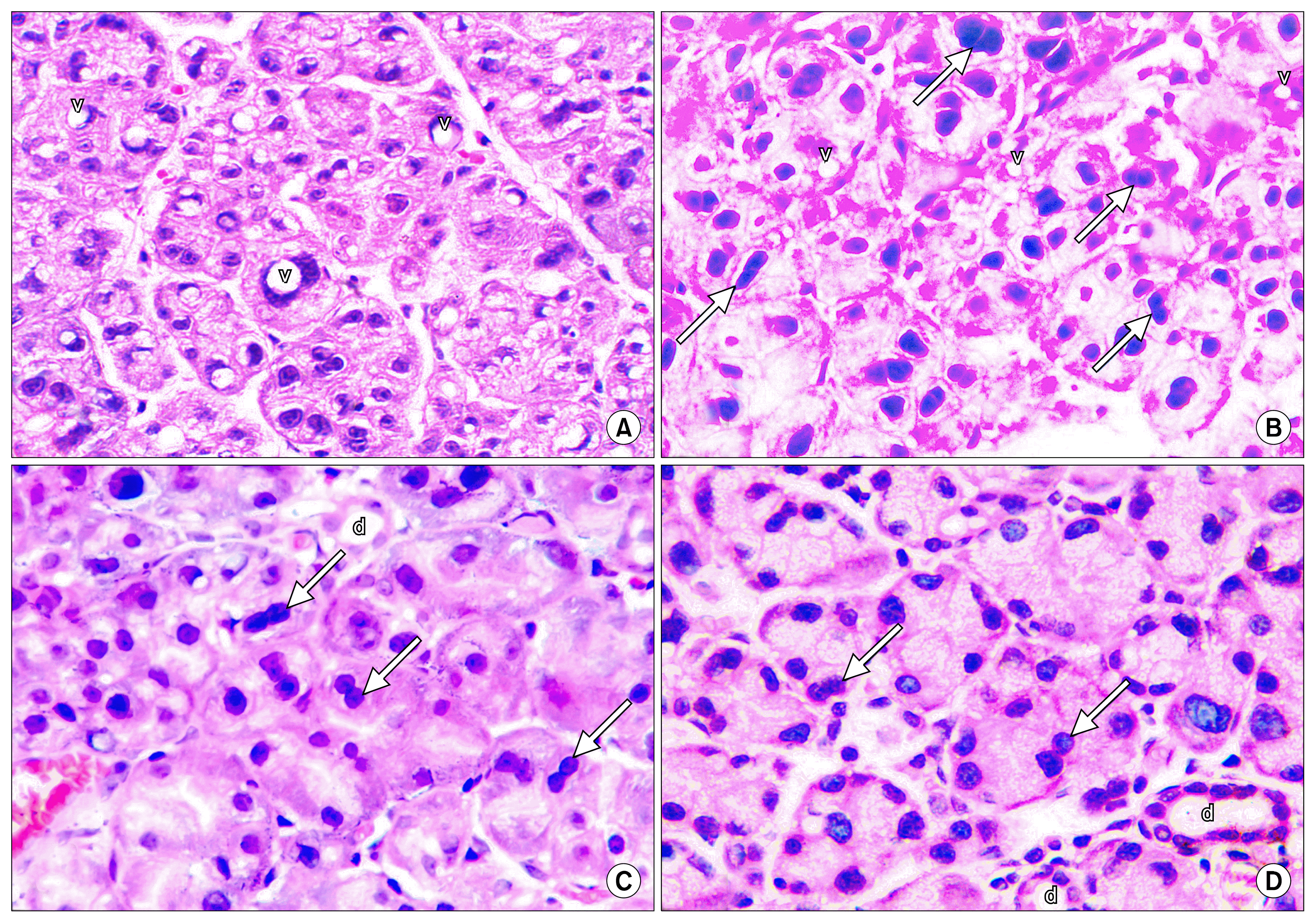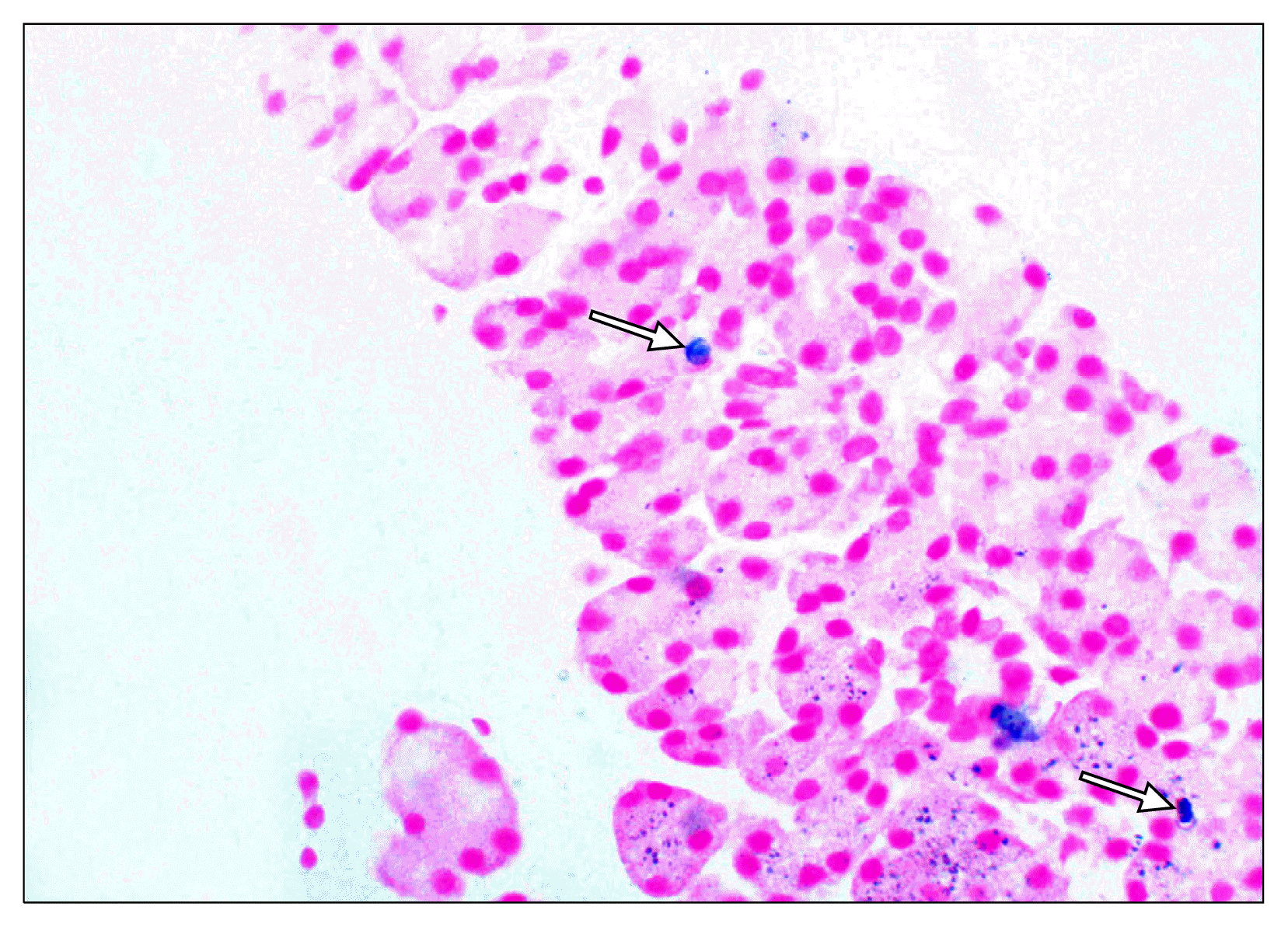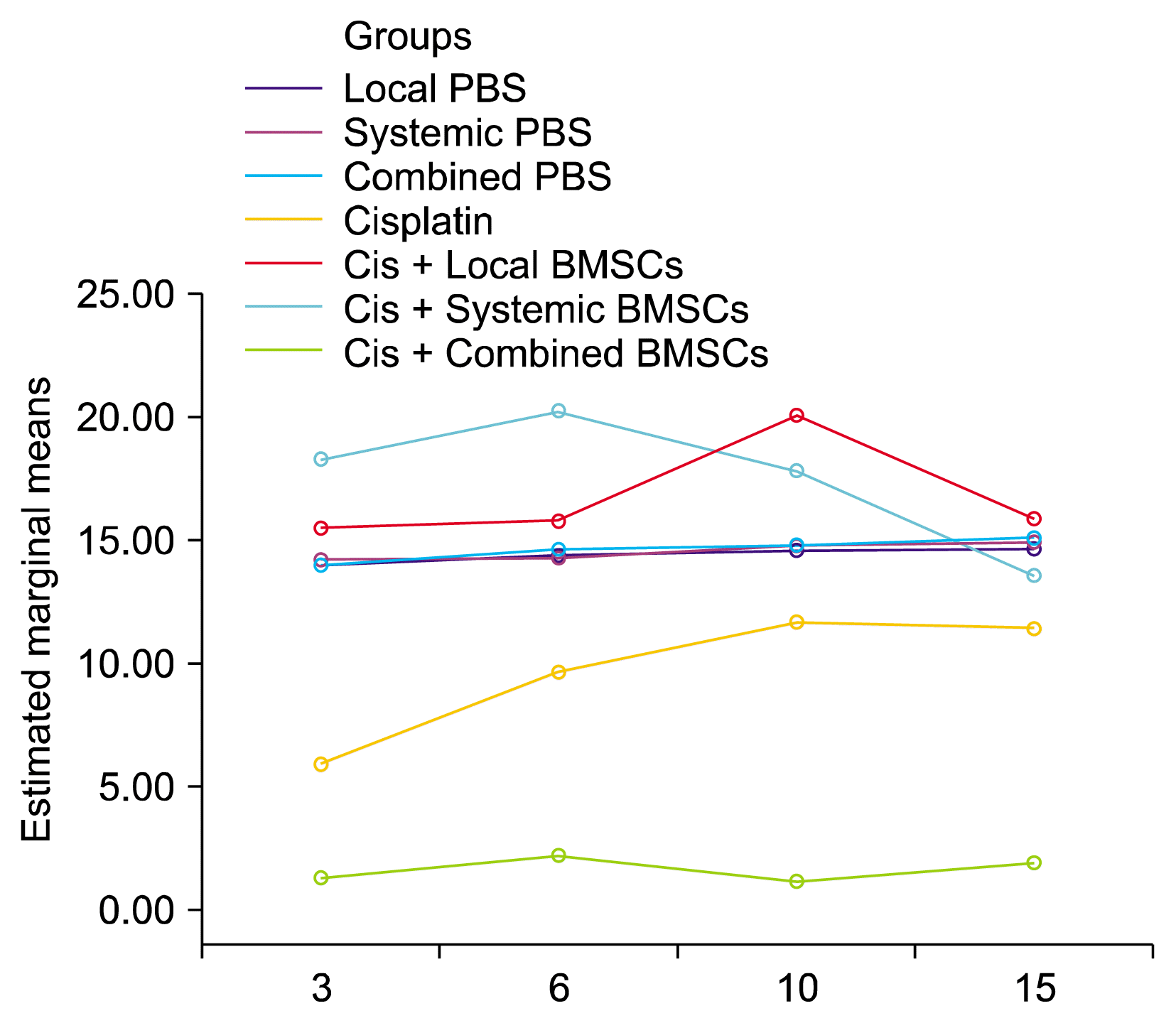1. Alcamo IE. Anatomy coloring workbook. 2nd ed. New York: Random House;2003. p. 222.
2. Wang G, Reed E, Li QQ. Molecular basis of cellular response to cisplatin chemotherapy in non-small cell lung cancer (Review). Oncol Rep. 2004; 12:955–965. PMID:
15492778.

3. López BC, Esteve CG, Pérez GS. Dental treatment considerations in the chemotherapy patient. J Clin Exp Dent. 2011; 3:e31–e42. DOI:
10.4317/jced.3.e31.

4. Kitashima S. Morphological alterations of submandibular glands caused by cisplatin in the rat. Kurume Med J. 2005; 52:29–38. DOI:
10.2739/kurumemedj.52.29. PMID:
16119610.

5. Hey J, Setz J, Gerlach R, Vordermark D, Gernhardt CR, Kuhnt T. Effect of Cisplatin on parotid gland function in concomitant radiochemotherapy. Int J Radiat Oncol Biol Phys. 2009; 75:1475–1480. DOI:
10.1016/j.ijrobp.2008.12.071. PMID:
19515505.

6. Wexler SA, Donaldson C, Denning-Kendall P, Rice C, Bradley B, Hows JM. Adult bone marrow is a rich source of human mesenchymal ‘stem’ cells but umbilical cord and mobilized adult blood are not. Br J Haematol. 2003; 121:368–374. DOI:
10.1046/j.1365-2141.2003.04284.x. PMID:
12694261.

7. Yen MH, Wu YY, Liu YS, Rimando M, Ho JH, Lee OK. Efficient generation of hepatic cells from mesenchymal stromal cells by an innovative bio-microfluidic cell culture device. Stem Cell Res Ther. 2016; 7:120. DOI:
10.1186/s13287-016-0371-7. PMID:
27542358. PMCID:
4992324.

9. Qi S, Wu D. Bone marrow-derived mesenchymal stem cells protect against cisplatin-induced acute kidney injury in rats by inhibiting cell apoptosis. Int J Mol Med. 2013; 32:1262–1272. DOI:
10.3892/ijmm.2013.1517. PMID:
24126885. PMCID:
3829764.

10. Liu J, Zhang H, Zhang Y, Li N, Wen Y, Cao F, Ai H, Xue X. Homing and restorative effects of bone marrow-derived mesenchymal stem cells on cisplatin injured ovaries in rats. Mol Cells. 2014; 37:865–872. DOI:
10.14348/molcells.2014.0145. PMID:
25410907. PMCID:
4275703.

11. Weil BR, Markel TA, Herrmann JL, Abarbanell AM, Meldrum DR. Mesenchymal stem cells enhance the viability and proliferation of human fetal intestinal epithelial cells following hypoxic injury via paracrine mechanisms. Surgery. 2009; 146:190–197. DOI:
10.1016/j.surg.2009.03.031. PMID:
19628073.

12. Sumita Y, Liu Y, Khalili S, Maria OM, Xia D, Key S, Cotrim AP, Mezey E, Tran SD. Bone marrow-derived cells rescue salivary gland function in mice with head and neck irradiation. Int J Biochem Cell Biol. 2011; 43:80–87. DOI:
10.1016/j.biocel.2010.09.023.

13. Lim JY, Yi T, Choi JS, Jang YH, Lee S, Kim HJ, Song SU, Kim YM. Intraglandular transplantation of bone marrow-derived clonal mesenchymal stem cells for amelioration of post-irradiation salivary gland damage. Oral Oncol. 2013; 49:136–143. DOI:
10.1016/j.oraloncology.2012.08.010.

14. Lin CY, Chang FH, Chen CY, Huang CY, Hu FC, Huang WK, Ju SS, Chen MH. Cell therapy for salivary gland regeneration. J Dent Res. 2011; 90:341–346. DOI:
10.1177/0022034510386374. PMID:
21297017.

15. Tran SD, Liu Y, Xia D, Maria OM, Khalili S, Wang RW, Quan VH, Hu S, Seuntjens J. Paracrine effects of bone marrow soup restore organ function, regeneration, and repair in salivary glands damaged by irradiation. PLoS One. 2013; 8:e61632. DOI:
10.1371/journal.pone.0061632. PMID:
23637870. PMCID:
3634855.

16. Lotfy A, Salama M, Zahran F, Jones E, Badawy A, Sobh M. Characterization of mesenchymal stem cells derived from rat bone marrow and adipose tissue: a comparative study. Int J Stem Cells. 2014; 7:135–142. DOI:
10.15283/ijsc.2014.7.2.135. PMID:
25473451. PMCID:
4249896.

17. Roldán-Fidalgo A, Martín Saldaña S, Trinidad A, Olmedilla-Alonso B, Rodríguez-Valiente A, García-Berrocal JR, Ramírez-Camacho R. In vitro and in vivo effects of lutein against cisplatin-induced ototoxicity. Exp Toxicol Pathol. 2016; 68:197–204. DOI:
10.1016/j.etp.2016.01.003. PMID:
26850526.

18. Jeong J, Baek H, Kim YJ, Choi Y, Lee H, Lee E, Kim ES, Hah JH, Kwon TK, Choi IJ, Kwon H. Human salivary gland stem cells ameliorate hyposalivation of radiation-damaged rat salivary glands. Exp Mol Med. 2013; 45:e58. DOI:
10.1038/emm.2013.121. PMID:
24232257. PMCID:
3849572.

19. Huang S, Xu L, Zhang Y, Sun Y, Li G. Systemic and local administration of allogeneic bone marrow-derived mesenchymal stem cells promotes fracture healing in rats. Cell Transplant. 2015; 24:2643–2655. DOI:
10.3727/096368915X687219. PMID:
25647659.

20. Li XB, Schluesener HJ. Therapeutic effects of cisplatin on rat experimental autoimmune encephalomyelitis. Arch Immunol Ther Exp (Warsz). 2006; 54:51–53. DOI:
10.1007/s00005-006-0005-3.

21. Cepeda V, Fuertes MA, Castilla J, Alonso C, Quevedo C, Pérez JM. Biochemical mechanisms of cisplatin cytotoxicity. Anticancer Agents Med Chem. 2007; 7:3–18. DOI:
10.2174/187152007779314044. PMID:
17266502.

22. Fuertes MA, Castilla J, Alonso C, Pérez JM. Cisplatin biochemical mechanism of action: from cytotoxicity to induction of cell death through interconnections between apoptotic and necrotic pathways. Curr Med Chem. 2003; 10:257–266. DOI:
10.2174/0929867033368484. PMID:
12570712.

23. Casares C, Ramírez-Camacho R, Trinidad A, Roldán A, Jorge E, García-Berrocal JR. Reactive oxygen species in apoptosis induced by cisplatin: review of physiopathological mechanisms in animal models. Eur Arch Otorhinolaryngol. 2012; 269:2455–2459. DOI:
10.1007/s00405-012-2029-0. PMID:
22584749.

24. Izuwa Y, Kusaba J, Horiuchi M, Aiba T, Kawasaki H, Kurosaki Y. Comparative study of increased plasma quinidine concentration in rats with glycerol- and cisplatin-induced acute renal failure. Drug Metab Pharmacokinet. 2009; 24:451–457. DOI:
10.2133/dmpk.24.451. PMID:
19881257.

25. Lee JE, Nakagawa T, Kita T, Kim TS, Iguchi F, Endo T, Shiga A, Lee SH, Ito J. Mechanisms of apoptosis induced by cisplatin in marginal cells in mouse stria vascularis. ORL J Otorhinolaryngol Relat Spec. 2004; 66:111–118. DOI:
10.1159/000079329. PMID:
15316230.

26. Satoh M, Yoshihara T. Clinical and ultracytochemical investigation of sialadenosis. Acta Otolaryngol Suppl. 2004; (553):122–127. DOI:
10.1080/03655230410017814. PMID:
15277051.

27. McInnes EF. Background lesions in laboratory animals: a color atlas. China: Saunders Elsevier;2012. p. 49.
29. Quintana-Bustamante O, Alvarez-Barrientos A, Kofman AV, Fabregat I, Bueren JA, Theise ND, Segovia JC. Hematopoietic mobilization in mice increases the presence of bone marrow-derived hepatocytes via in vivo cell fusion. Hepatology. 2006; 43:108–116. DOI:
10.1002/hep.21005.

30. Rajantie I, Ilmonen M, Alminaite A, Ozerdem U, Alitalo K, Salven P. Adult bone marrow-derived cells recruited during angiogenesis comprise precursors for periendothelial vascular mural cells. Blood. 2004; 104:2084–2086. DOI:
10.1182/blood-2004-01-0336. PMID:
15191949. PMCID:
2698665.

31. Zarjou A, Kim J, Traylor AM, Sanders PW, Balla J, Agarwal A, Curtis LM. Paracrine effects of mesenchymal stem cells in cisplatin-induced renal injury require heme oxygenase-1. Am J Physiol Renal Physiol. 2011; 300:F254–F262. DOI:
10.1152/ajprenal.00594.2010. PMCID:
3023217.

32. Zhao W, Li JJ, Cao DY, Li X, Zhang LY, He Y, Yue SQ, Wang DS, Dou KF. Intravenous injection of mesenchymal stem cells is effective in treating liver fibrosis. World J Gastroenterol. 2012; 18:1048–1058. DOI:
10.3748/wjg.v18.i10.1048. PMID:
22416179. PMCID:
3296978.

33. Guo W, Wang H, Zou S, Gu M, Watanabe M, Wei F, Dubner R, Huang GT, Ren K. Bone marrow stromal cells produce long-term pain relief in rat models of persistent pain. Stem Cells. 2011; 29:1294–1303. DOI:
10.1002/stem.667. PMID:
21630378. PMCID:
3277433.

34. McFarlin K, Gao X, Liu YB, Dulchavsky DS, Kwon D, Arbab AS, Bansal M, Li Y, Chopp M, Dulchavsky SA, Gautam SC. Bone marrow-derived mesenchymal stromal cells accelerate wound healing in the rat. Wound Repair Regen. 2006; 14:471–478. DOI:
10.1111/j.1743-6109.2006.00153.x. PMID:
16939576.

35. Kwon DS, Gao X, Liu YB, Dulchavsky DS, Danyluk AL, Bansal M, Chopp M, McIntosh K, Arbab AS, Dulchavsky SA, Gautam SC. Treatment with bone marrow-derived stromal cells accelerates wound healing in diabetic rats. Int Wound J. 2008; 5:453–463. DOI:
10.1111/j.1742-481X.2007.00408.x. PMID:
18593394. PMCID:
3852907.

36. Aly LA, El-Menoufy H, Sadeq HS, Ragae A, Sabry D. Efficiency of systemic versus intralesional bone marrow-derived stem cells in regeneration of oral mucosa after induction of formocresol induced ulcers in dogs. Dent Res J (Isfahan). 2014; 11:212–221.
37. Muschler GF, Nakamoto C, Griffith LG. Engineering principles of clinical cell-based tissue engineering. J Bone Joint Surg Am. 2004; 86-A:1541–1558. DOI:
10.2106/00004623-200407000-00029. PMID:
15252108.

38. Abbah SA, Spanoudes K, O’Brien T, Pandit A, Zeugolis DI. Assessment of stem cell carriers for tendon tissue engineering in pre-clinical models. Stem Cell Res Ther. 2014; 5:38. DOI:
10.1186/scrt426. PMID:
25157898. PMCID:
4056691.

39. Schwarz S, Huss R, Schulz-Siegmund M, Vogel B, Brandau S, Lang S, Rotter N. Bone marrow-derived mesenchymal stem cells migrate to healthy and damaged salivary glands following stem cell infusion. Int J Oral Sci. 2014; 6:154–161. DOI:
10.1038/ijos.2014.23. PMID:
24810808. PMCID:
4170149.

40. Papadimitriou N, Li S, Barreto Henriksson H. Iron sucrose-labeled human mesenchymal stem cells: in vitro multilineage capability and in vivo traceability in a lapine xenotransplantation model. Stem Cells Dev. 2015; 24:2403–2412. DOI:
10.1089/scd.2015.0140. PMID:
26076769.







 PDF
PDF Citation
Citation Print
Print





 XML Download
XML Download